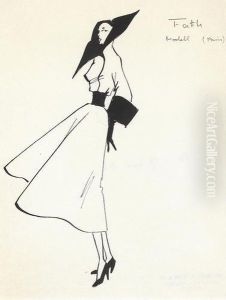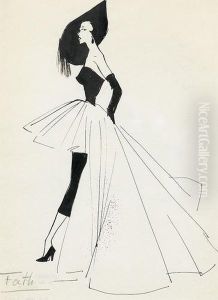Jacques Fath Paintings
Jacques Fath was a French fashion designer, considered one of the three dominant influences on postwar haute couture, the others being Christian Dior and Pierre Balmain. Born on September 6, 1912, in Maisons-Laffitte, Yvelines, France, Fath came from a creative family with artistic roots – his mother was a painter, and his grandmother designed clothing.
In the early 1930s, Jacques Fath moved to Paris to embark on a career in fashion. He opened his first studio in 1937, starting with a small salon on Rue de la Boetie. The business grew, and by 1939, Fath presented his first collection. His designs quickly gained recognition for their seductive and glamorous aesthetic, which resonated with the era's appetite for luxury and femininity.
The outbreak of World War II and the occupation of Paris by German forces did not stop Fath from continuing his work. Despite the difficult circumstances, he managed to keep his fashion house operational, catering to the needs of the wealthy and the cinema industry, which thrived during this time. His designs from the wartime period are noted for their resourceful use of limited materials due to wartime restrictions, often demonstrating a sense of daring and innovation.
Following the war, Fath's fashion house became one of the most influential in Paris, contributing to the re-establishment of Paris as the center of the fashion world. His designs were characterized by their bold silhouettes, opulent fabrics, and intricate detailing. He had a flair for dramatic, yet sophisticated, evening gowns and was known for his ability to sculpt fabric directly onto a mannequin to create elegant forms.
Jacques Fath's clientele included celebrities and socialites, and his influence extended beyond couture to perfumes and accessories, helping to solidify his brand as a symbol of French elegance and style. Unfortunately, Fath's life and career were cut short when he died of leukemia on November 13, 1954, at the age of 42.
Despite his premature death, Jacques Fath left a lasting legacy in the world of fashion. His wife, Geneviève Fath, continued to run the fashion house for a few years following his death, and the brand has been revived several times since, with various designers attempting to capture Fath's original spirit and style. His work remains an important reference point for fashion designers and historians alike, and his contribution to the postwar fashion renaissance continues to be celebrated.

